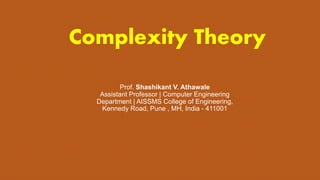
teteuueieoeofhfhfjffkkkfkfflflflhshssnnvmvvmvv,v,v,nnxmxxm
- 1. Complexity Theory Prof. Shashikant V. Athawale Assistant Professor | Computer Engineering Department | AISSMS College of Engineering, Kennedy Road, Pune , MH, India - 411001
- 2. CONTENTS 1. Asymptotic notation 2. Deterministic Algorithm 3. Non-Deterministic Algorithm 4. Difference between Deterministic Algorithm & Non-Deterministic Algorithm 5. P problems 6. NP problems 7. Difference between P and NP problems 8. 3-Satisfiability 9. Hamiltonian Cycle
- 3. Asymptotic notation • Big Theta (T) • Big Oh(O) • Big Omega ()
- 4. • The Big O notation defines an upper bound of an algorithm, it bounds a function only from above. For example, consider the case of Insertion Sort. • g(n) is upper bound of the f(n) if there is exists some positive constants c and n0.It is denoted as f(n)=O(g(n)). • The Big Omega notation defines an lower bound of an algorithm. • Running time of the algorithem cannot be less than asymptotic lower bound for sequence of the data. • Big Theta defines the tight bound for the algorithem. • Running time of the algorithem cannot be less than or greater than its asymptotic tight bound for random sequence of the data.
- 5. DETERMINISTIC ALGORITHM • In Deteministic algorithem For a particular input the computer will give same output every time. • examples are finding odd or even,sorting,finding max etc. • Most of the algorithem are deterministic in nature.
- 6. NON-DETERMINISTIC ALGORITHM • In non deterministic algorithem for a same input the computer will give different output on different execution. • This algorithem operates in two phases Guessing and Verification. • Randomly picking some elements from the list and check if it is maximum is non-deterministic.
- 7. Difference between Deterministic and Non- deterministic Algorithms Deterministic Algorithm • For a particular input the computer will give different output on different execution. • Can solve the problem in polynomial time. Non-deterministic Algorithm • For a particular input the computer will give different output on different execution. • Can’t solve the problem in polynomial time.
- 8. P and NP class Problem P class NP class NP Complete NP hard
- 9. P-Class Problem • The class P consists of those problems that are solvable in polynomial time, i.e. these problems can be solved in time O(nk) in worst-case, where k is constant. • These problems are called tractable, while others are called intractable or super polynomial. • The advantages in considering the class of polynomial-time algorithms is that all reasonable deterministic single processor model of computation can be simulated on each other with at most a polynomial slow-d
- 10. NP-Class Problem • The class NP consists of those problems that are verifiable in polynomial time. NP is the class of decision problems for which it is easy to check the correctness of a claimed answer, with the aid of a little extra information. • Every problem in this class can be solved in exponential time using exhaustive search.
- 11. Difference between P and NP class problem • All problems in P can be solved with polynomial time algorithms, whereas all problems in NP - P are intractable. • P is set of problems that can be solved by a deterministic Turing machine in Polynomial time. • NP is set of decision problems that can be solved by a Non- deterministic Turing Machine in Polynomial time. • NP-complete problems are the hardest problems in NP set.
- 12. NP-complete problems A decision problem L is NP-complete if: 1) L is in NP (Any given solution for NP-complete problems can be verified quickly, but there is no efficient known solution). 2) Every problem in NP is reducible to L in polynomial time (Reduction is defined below). A problem is NP-Hard if it follows property 2 mentioned above, doesn’t need to follow property 1. Therefore, NP-Complete set is also a subset of NP-Hard set.
- 13. Examples: • Knapsack problem • Hamiltonian path problem • vertex cover problem • Boolen satisfiabiltiy problem • clique problem
- 14. 3-Satisfiability • Satisfiability's role as the first NP-complete problem implies that the problem is hard to solve in the worst case, but certain instances of the problem are not necessarily so tough. . • Input: A collection of clauses C where each clause contains exactly 3 literals, over a set of Boolean variables V. • Output: Is there a truth assignment to V such that each clause is satisfied? Since this is a more restricted problem than satisfiablity, the hardness of 3-SAT implies that satisfiability is hard. The converse isn't true, as the hardness of general satisfiability might depend upon having long clauses. We can show the hardness of 3-SAT using a reduction that translates every instance of satisfiability into an instance of 3-S.
- 15. Hamiltonian Cycle Hamiltonian Path in an undirected graph is a path that visits each vertex exactly once. A Hamiltonian cycle (or Hamiltonian circuit) is a Hamiltonian Path such that there is an edge (in the graph) from the last vertex to the first vertex of the Hamiltonian Path.
- 16. Thank you